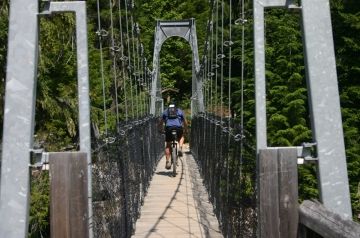Riverside Trail

Trail Length: 6.3 kilometres
Difficulty: Moderate
Park Amenities:
The first section - the Riverside Interpretive Trail - is a hiking-only 1 kilometre easy-grade trail following a well maintained earthy path into the forest. The route explores the trees with many interpretive signs posted along the way about the local forest and wildlife in the area.
Some of the trees in the interpretive area were born in the early 1700's. There are western hemlock, western red cedar and balsam trees in the protected buffer zone. Buffer zones protect stream banks, provide shade and produce litterfall (nutrients for fish falling from trees).
The second section - Lower Riverside Trail - continues from the interpretive trail further up the mountain. It is more about hiking, mountain biking and scenery from here on in. The trail is a mixture of gravel road and single - track routes connecting to other trails like the Farside Trail and Ridge Trail... plus it leads to Logger's Lake.
The Riverside Trail, along with the Ridge Trail, are the more popular hiking and mountain biking routes in the Whistler Interpretive Forest because they act as connector trails to other trails in the region.
From the Riverside Trail to the suspension bridge to Farside Trail Loop is 6.3 kilometres. The Riverside Trail to Loggers Lake is 3.5 kilometres. Riverside Trail to House Rock is 4.1 kilometres. All trail routes are multi use trails explored by both, hikers and mountain bikers. Each route is an opportunity to learn more about the wildlife, geological formations and forest types of the region.
Explore Riverside Trail in the Whistler Interpretive Forest in Whistler, British Columbia, Canada
Address:








